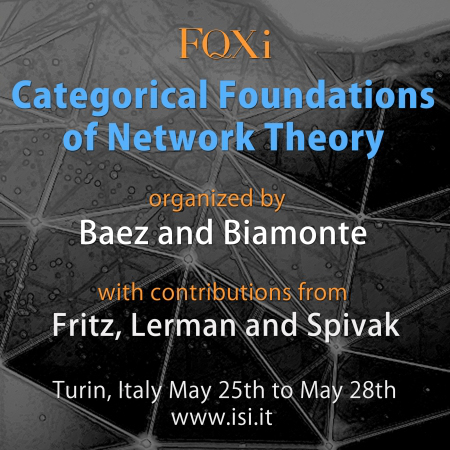John C. Baez's Blog, page 80
April 15, 2015
Kinetic Networks: From Topology to Design
Here’s an interesting conference for those of you who like networks and biology:
• Kinetic networks: from topology to design, Santa Fe Institute, 1719 September, 2015. Organized by Yoav Kallus, Pablo Damasceno, and Sidney Redner.
Proteins, self-assembled materials, virus capsids, and self-replicating biomolecules go through a variety of states on the way to or in the process of serving their function. The network of possible states and possible transitions between states plays a central role...
April 12, 2015
Resource Convertibility (Part 3)
guest post by Tobias Fritz
In Part 1 and Part 2, we learnt about ordered commutative monoids and how they formalize theories of resource convertibility and combinability. In this post, I would like to say a bit about the applications that have been explored so far. First, the study of resource theories has become a popular subject in quantum information theory, and many of the ideas in my paper actually originate there. I’ll list some references at the end. So I hope that the toolbox of order...
April 9, 2015
Resource Convertibility (Part 2)
guest post by Tobias Fritz
In Part 1, I introduced ordered commutative monoids as a mathematical formalization of resources and their convertibility. Today I’m going to say something about what to do with this formalization. Let’s start with a quick recap!
Definition: An ordered commutative monoid is a set  equipped with a binary relation
equipped with a binary relation  a binary operation
a binary operation  and a distinguished element
and a distinguished element  such that the following hold:
such that the following hold:
•  and
and  equip
equip  with the structure of a commutative monoid;
with the structure of a commutative monoid;
•  equips
equips  with t...
with t...
April 6, 2015
Resource Convertibility (Part 1)
guest post by Tobias Fritz
Hi! I am Tobias Fritz, a mathematician at the Perimeter Institute for Theoretical Physics in Waterloo, Canada. I like to work on all sorts of mathematical structures which pop up in probability theory, information theory, and other sorts of applied math. Today I would like to tell you about my latest paper:
• The mathematical structure of theories of resource convertibility, I.
It should be of interest to Azimuth readers as it forms part of what John likes to call ‘...
Information and Entropy in Biological Systems (Part 3)
I think you can watch live streaming video of our workshop on Information and Entropy in Biological Systems, which runs Wednesday April 8th to Friday April 10th. Later, videos will be made available in a permanent location.
To watch the workshop live, go here. Go down to where it says
Investigative Workshop: Information and Entropy in Biological Systems
Then click where it says live link. There’s nothing there now, but I’m hoping there will be when the show starts!
Below you can see the sch...
April 3, 2015
Categorical Foundations of Network Theory

Jacob Biamonte got a grant from the Foundational Questions Institute to run a small meeting on network theory:
• The categorical foundations of network theory.
It’s being held 25-28 May 2015 in Turin, Italy, at the ISI Foundation. We’ll make slides and/or videos available, but the main goal is to bring a few people together, exchange ideas, and push the subject forward.
The ideaNetwork theory is a diverse subject which developed independently in several disciplines. It uses graphs with...
April 1, 2015
A Networked World (Part 3)
guest post by David Spivak
From parts to wholesRemember where we were. Ologs, linguistically-enhanced sketches, just werent doing justice to the idea that each step in a recipe is itself a recipe. But the idea seemed ripe for mathematical formulation.
Thus, I returned to a question Id wondered about in the very beginning: how is macro-understanding built from micro-understanding? How can multiple individual humans come together, like cells in a multicellular organism, to make a whole that is...
March 29, 2015
A Networked World (Part 2)
guest post by David Spivak
Creating a knowledge networkIn 2007, I asked myself: as mathematically as possible, what can formally ground meaningful information, including both its successful communication and its role in decision-making? I believed that category theory could be useful in formalizing the type of object that we call information, and the type of relationship that we call communication.
Over the next few years, I worked on this project. I tried to understand what information is,...
March 26, 2015
A Networked World (Part 1)
guest post by David Spivak
The problemThe idea thats haunted me, and motivated me, for the past seven years or so came to me while reading a book called The Moment of Complexity: our Emerging Network Culture, by Mark C. Taylor. It was a fascinating book about how our world is becoming increasingly networkedwired up and connectedand that this is leading to a dramatic increase in complexity. Im not sure if it was stated explicitly there, but I got the idea that with the advent of the World W...
March 24, 2015
Stationary Stability in Finite Populations
guest post by Marc Harper
A while back, in the article Relative entropy minimization in evolutionary dynamics, we looked at extensions of the information geometry / evolutionary game theory story to more general time-scales, incentives, and geometries. Today we’ll see how to make this all work in finite populations!
Let’s recall the basic idea from last time, which John also described in his information geometry series. The main theorem is this: when there’s an evolutionarily stable state for...
John C. Baez's Blog
- John C. Baez's profile
- 29 followers



